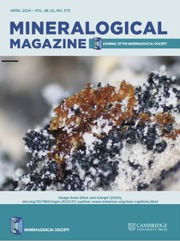Article contents
Stabilization of trivalent Mn in natural tetragonal hydrogarnets on the join ‘hydrogrossular’—henritermierite, Ca3Mn2 3+ [SiO4]2[H4O4]
Published online by Cambridge University Press: 05 July 2018
Abstract
Four relatively intense and broad absorption bands centred at ∼12500, ∼19500, ∼21500 and ∼23000 cm–1 were recorded in polarized electronic single-crystal spectra of natural, optically uniaxial and pleochroic hydrogarnets with henritermierite contents ranging from 35 to 97 mol.%. These absorption bands arise from spin-allowed electronic d-d transitions in trivalent Mn located at the axially distorted six-coordinated site of the tetragonal hydrogarnet structure.
The crystal field stabilization energy (CFSE) for trivalent Mn at the Mn site, as derived from band energies, is ∼185 kJ/mol. This considerably higher CFSE for Mn3+ in tetragonal hydrogarnets as compared to cubic garnets (130 –145 kJ/mol) explains the natural occurrence of close to end-member tetragonal Mn3+-hydrogarnets while only limited Mn3+-substitution is observed in natural cubic garnets.
The fact that incorporation of Mn3+ at intermediate concentrations stabilizes the tetragonal hydrogarnets indicates the potential natural existence of a number of new, partially Mn3+-substituted, hydrogarnets, e.g. tetragonal Mn3+-bearing ‘hydroandradite’.
Information
- Type
- Research Article
- Information
- Copyright
- Copyright © The Mineralogical Society of Great Britain and Ireland 2004
References
- 8
- Cited by

